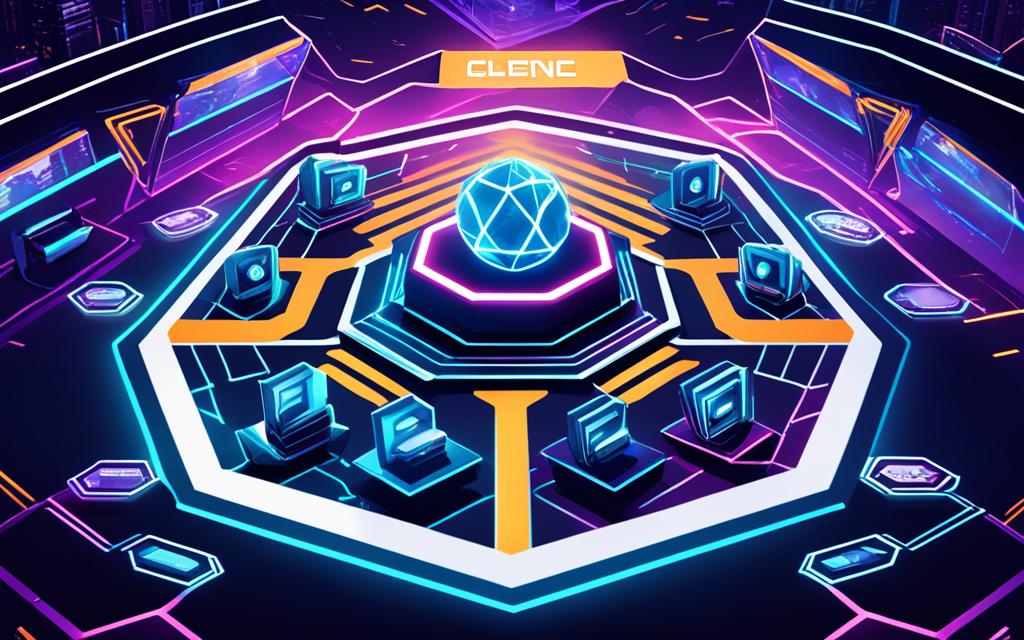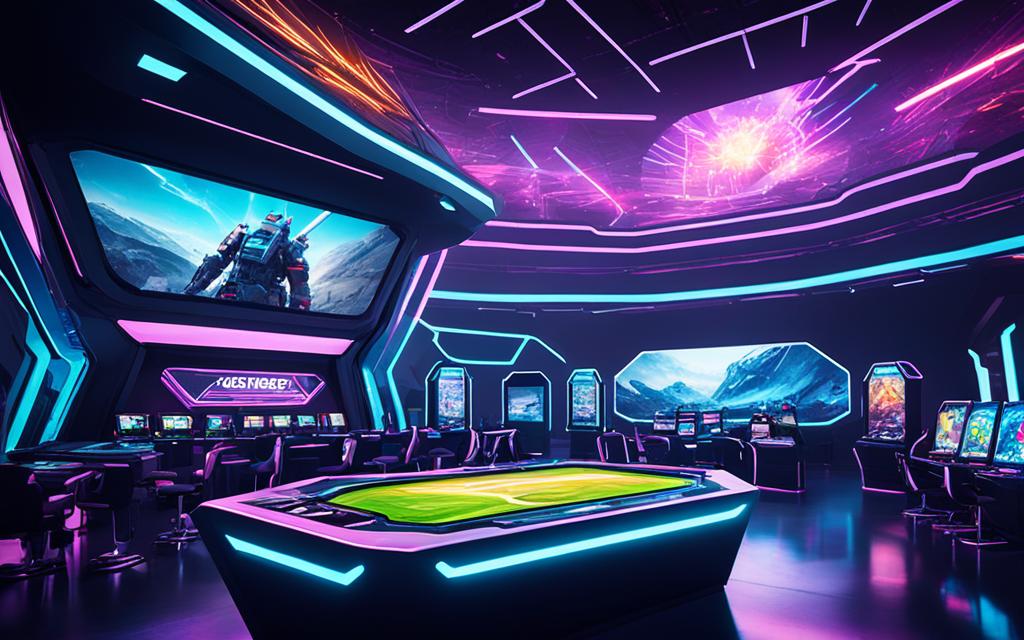The gaming industry is constantly evolving, and the next decade is expected to bring groundbreaking advancements in high-end gaming. With new technologies, shifting player preferences, and changing market dynamics, the future of gaming holds immense potential. Let’s explore the top predictions for the gaming industry and how they will shape the landscape in the coming years.
The future of the gaming industry is bright, with several exciting trends on the horizon. From cutting-edge graphics and immersive virtual reality experiences to the integration of artificial intelligence and the rise of esports, high-end gaming is set to transform in the next decade. Here’s a glimpse into what the future holds:
Embracing Artistic and Stylized Graphics
Shift from Hyperrealism to Unique Art Styles
Artistic and stylized graphics will take center stage in the next decade, as developers move away from hyperrealistic visuals and explore more distinctive art styles. This shift will allow games to stand out and captivate players with visually unique and immersive experiences.
Impact of Aesthetic Choices on Game Development
Aesthetic choices in game development will have a profound impact on player experiences. From the art direction to the storytelling, the carefully crafted visual elements will enhance immersion and engagement, creating unforgettable gaming moments.
Integration of VR and AR into Mainstream Gaming
Virtual Reality (VR) and Augmented Reality (AR) will become increasingly prevalent in high-end gaming. VR technologies will overcome current limitations, offering players more immersive and realistic experiences. At the same time, AR will blend the digital and physical worlds, providing innovative gameplay experiences that push the boundaries of what is possible.
Advancements in Artificial Intelligence
Artificial Intelligence (AI) will continue to advance, revolutionizing gameplay and visuals. AI-powered gameplay will become more dynamic and intelligent, enhancing graphics, physics engines, and NPC behavior. These advancements will create more immersive and realistic gaming worlds for players to explore.
Gaming Industry Trends of Cloud-Based Services
Cloud-based services will reshape the gaming industry, with cloud gaming and game streaming platforms gaining popularity. Cloud gaming will eliminate the need for high-end hardware, making games more accessible to a wider audience. Game streaming platforms will offer a convenient way to access a vast library of titles and enjoy seamless gameplay experiences.
Social Elements Transforming Gaming Experiences
The social aspect of gaming will grow in importance, with multiplayer experiences, cooperative gameplay, and community interaction taking center stage. Developers are incorporating social features to create shared experiences, competitions, and collaborative gameplay, fostering social connections among players.
Esports: The Meteoric Rise in Popularity
Esports has experienced exponential growth and will continue to thrive in the next decade. Professional gaming leagues, tournaments, and events will attract a massive following, with esports integrating into traditional sports venues. This convergence of esports and traditional sports will provide fans with new opportunities to engage with professional gaming.
Blockchain and its Economic Impact on Gaming
Blockchain technology will revolutionize the gaming economy, enabling secure ownership and trading of in-game assets and currencies. Players will have more control over their virtual possessions, while developers will unlock new monetization opportunities within the gaming ecosystem.
The Role of High-Fidelity Graphics in Future Gaming
High-fidelity graphics will play a crucial role in shaping the future of gaming. Developers will strive to bridge the uncanny valley, creating visuals that are more realistic and immersive than ever before. Advancements in graphics technology will push the boundaries, enhancing player experiences and transporting them to breathtaking virtual worlds.
Free-to-Play Models and New Monetization Strategies
Free-to-play models will continue to dominate the gaming industry, allowing players to access games without upfront costs. Developers will explore new monetization strategies such as microtransactions and in-game purchases, ensuring sustainable revenue generation while providing players with engaging and enjoyable experiences.
The Emergence of the Metaverse in Gaming
The concept of the metaverse will revolutionize gaming, providing interactive and persistent online worlds that transcend platforms and devices. Developers aim to create interconnected game universes that offer cross-platform experiences, enabling seamless gameplay and immersive virtual worlds.
Gaming Market Trends: Analyzing Consumer Demographics
Gaming is a multi-generational form of entertainment, embraced by people of all ages. The global gaming audience is expanding, with emerging markets playing a significant role in the industry’s growth. Understanding the diverse demographics and preferences within the gaming community will be crucial for developers and industry professionals.
Conclusion
The next decade will be a transformative period for the high-end gaming industry. From advancements in technology to evolving player experiences and market trends, the future of gaming is full of exciting possibilities. By staying informed about these predictions and trends, players, developers, and industry professionals can prepare for the incredible journey ahead in the world of high-end gaming.
Key Takeaways:
- The next decade will bring a shift towards artistic and stylized graphics, enhancing the visual appeal of games.
- VR and AR technologies will play an increasing role in gaming, offering immersive experiences.
- Advancements in AI will result in more intelligent gameplay and realistic virtual worlds.
- Cloud-based services will reshape the industry, providing accessibility and convenience to players.
- Esports will continue to grow, integrating with traditional sports and attracting a wider audience.
Embracing Artistic and Stylized Graphics
In the next decade, game graphics are set to undergo a transformation, shifting from the hyperrealism that has dominated the industry to more artistic and stylized approaches. Developers are increasingly recognizing the power and impact of aesthetic choices in game development, paving the way for visually unique games with distinct art styles that captivate players.
Artistic game graphics and unique art styles are becoming important aspects of game design. By veering away from hyperrealism, developers can create visually stunning games that stand out in the crowded gaming market. These stylized game graphics allow for greater creativity and innovation in delivering immersive virtual worlds that players can get lost in.
The shift from hyperrealism to unique art styles has a significant impact on game development and player experience. Aesthetic choices play a crucial role in shaping the overall game environment, characters, and storytelling. The art direction in game development sets the tone and atmosphere, evoking specific emotions and enhancing player engagement.
The importance of aesthetic choices in game development cannot be overstated. The influence of graphics on player experience is immense, affecting immersion, emotional connection, and overall enjoyment. When executed well, artistic and stylized graphics elevate a game beyond being simply visually appealing; they become an essential component of the gameplay itself, enhancing the storytelling and gameplay mechanics.
Integration of VR and AR into Mainstream Gaming
In the fast-paced world of gaming, virtual reality (VR) and augmented reality (AR) technologies are set to revolutionize the industry in the coming years. The future of gaming will be characterized by immersive experiences, realistic simulations, and the integration of digital elements into the real world. Both VR and AR offer unique opportunities for players to engage with games on a whole new level.
Virtual Reality: Overcoming Current Limitations
Virtual Reality gaming has come a long way since its inception, and it continues to evolve at a rapid pace. One of the biggest challenges VR technology has faced is overcoming its current limitations to provide a more seamless and immersive experience. However, advancements in VR technology are paving the way for more realistic visuals, improved motion tracking, and enhanced haptic feedback.
With the future of virtual reality gaming, players will be transported to fully immersive and interactive virtual worlds. They will be able to explore new environments, interact with objects and characters, and experience gameplay in ways that were previously unimaginable. VR gaming experiences will be more engaging, allowing players to truly step into the shoes of their in-game characters and feel like they are part of the virtual world.
The Growth Trajectory of Augmented Reality in Games
Augmented Reality has seen significant growth in recent years, with popular games like Pokémon Go demonstrating the potential of blending digital and physical worlds. As technology advances, AR will continue to find its place in mainstream gaming and expand its horizons.
The integration of augmented reality in mainstream gaming will offer players a unique gaming experience that combines the real world with digital enhancements. Players will be able to interact with virtual objects and characters in their physical surroundings, bringing a whole new level of immersion. This integration will open up endless possibilities for innovative gameplay mechanics, storytelling, and social interactions.
Furthermore, AR technology will not only enrich gaming experiences but also have applications beyond entertainment. Industries like education, healthcare, and architecture are already exploring the potential of AR to improve training, visualization, and problem-solving.
The future of gaming is set to be a blend of virtual and augmented reality, where players can explore immersive virtual worlds or enhance their real-world experiences with digital elements. The integration of VR and AR into mainstream gaming will offer players unprecedented levels of immersion, interaction, and storytelling.
Advancements in Artificial Intelligence
Artificial Intelligence (AI) is set to revolutionize the gaming industry with its continuous advancements. In the next decade, AI will play a key role in enhancing gameplay experiences and pushing the boundaries of graphics and physics engines.
One of the major areas where AI will have a significant impact is in intelligent gameplay. AI algorithms will allow game characters and non-playable characters (NPCs) to exhibit more realistic and dynamic behavior. This will create more immersive and engaging gameplay scenarios, where NPCs can adapt to the player’s actions and make intelligent decisions.
Furthermore, AI will also contribute to improved graphics and physics engines. By leveraging AI algorithms, developers can enhance the visual quality of games by generating more realistic textures, lighting effects, and character animations. AI can also optimize physics engines to provide more accurate and lifelike interactions between objects and environments, enhancing the overall realism of the gaming experience.
AI advancements in gaming will enable more intelligent gameplay, improved graphics, and enhanced physics engines, leading to more immersive and realistic gaming experiences.
Game developers are increasingly utilizing AI technologies to create more immersive and realistic worlds for players to explore. The integration of AI in gaming has the potential to significantly enhance the overall gaming experience and open up new possibilities for future advancements.

| Benefits of AI in Gaming | Examples |
|---|---|
| Intelligent gameplay | AI-controlled NPCs adapting to player actions |
| Improved graphics | Realistic textures, lighting effects, and character animations |
| Enhanced physics engines | Accurate and lifelike interactions between objects and environments |
Gaming Industry Trends of Cloud-Based Services
Cloud-based services have brought about significant advancements in the gaming industry, particularly through cloud gaming and game streaming platforms. These trends have reshaped the way games are accessed and owned, providing various benefits and increased accessibility for players.
How Cloud Gaming is Reshaping Access and Ownership
Cloud gaming has revolutionized the way games are played by allowing players to access and enjoy their favorite titles from any device, without the need for high-end hardware. This trend has eliminated the barrier of expensive gaming systems, making gaming more accessible and affordable for a wider audience.
Cloud gaming also offers the advantage of not being tied to physical game copies or installations. Players can simply stream games directly to their devices, eliminating the need for downloads or updates. This seamless experience allows for instant play, saving time and providing more flexibility for gamers.
The Expansion of Game Streaming Platforms
Game streaming platforms have experienced significant growth, offering players a wide range of titles and the convenience of accessing games on-demand. These platforms provide a vast library of games that can be streamed directly to a player’s device, enabling them to enjoy a diverse gaming experience without the need for physical copies or installations.
Popular game streaming platforms such as Twitch, YouTube Gaming, and Microsoft’s xCloud have gained immense popularity, providing players with a platform to discover new games, watch live gameplay, and interact with their favorite streamers. This integration of gaming and streaming has created a thriving community of players and content creators, further enhancing the gaming experience.
The growth of game streaming platforms has not only expanded the reach of gaming but has also opened up new avenues for content creation, esports, and professional gaming. These platforms have become an integral part of the gaming industry, shaping the way games are played, shared, and enjoyed.
Social Elements Transforming Gaming Experiences
The social aspect of gaming is becoming increasingly important, with social gaming trends shaping the way players interact with games. It goes beyond playing alone and immerses players in a world of connection and collaboration. Multiplayer experiences are at the forefront of this transformation, allowing players to engage with others in real-time.
Whether it’s teaming up with friends to complete missions in a cooperative gameplay or competing against other players in online multiplayer modes, these experiences enhance multiplayer experiences by fostering competition, teamwork, and camaraderie. Players can create shared memories and meaningful relationships through their gaming interactions.
Furthermore, community interaction is a key component of modern gaming. Gaming communities provide a platform for players to connect, discuss their favorite games, share strategies, and offer support. Developers are incorporating social features into games to encourage community interaction and create a sense of belonging.
The integration of chat functionalities, social media sharing options, and in-game events promote community interaction in gaming. Players can engage in lively discussions, join tournaments or events, and showcase their achievements. These social elements bring gamers together, fostering a sense of community and enhancing the overall gaming experience.
As the gaming industry continues to evolve, developers are prioritizing the social aspect of gaming to create memorable experiences. By embracing social gaming trends, multiplayer experiences, and community interaction, they are transforming gaming into a more social and inclusive space.

Esports: The Meteoric Rise in Popularity
In recent years, esports has witnessed an extraordinary surge in popularity, captivating a global audience and transforming the landscape of competitive gaming. As we look toward the future, it becomes evident that esports is here to stay and will continue to thrive in the next decade.
Trends and Future Outlook for Esports
One of the most compelling trends in the esports industry is the exponential growth of professional gaming leagues, tournaments, and events. Esports competitions have evolved from small-scale gatherings to massive spectacles, attracting millions of viewers worldwide.
The future of esports holds immense potential, with the industry poised for continued growth and expansion. As technologies advance and gaming experiences become more immersive, the popularity of esports is expected to soar even higher. The integration of virtual reality (VR) and augmented reality (AR) technologies will add new dimensions to competitive gaming, enhancing player experiences and captivating audiences in unprecedented ways.
Furthermore, the convergence of esports and traditional sports is a notable trend that will shape the future of both industries. We can anticipate the integration of esports in traditional sports venues, such as stadiums and arenas, where fans can gather to watch their favorite teams compete on grand stages.
Integration of Esports in Traditional Sports Venues
The integration of esports in traditional sports venues opens up new possibilities for spectators and fans to engage with professional gaming. The electrifying atmosphere of stadiums, combined with the adrenaline-filled competition of esports, creates an unforgettable experience for both players and viewers.
By hosting esports events in stadiums, traditional sports venues can tap into the immense fan base of gaming enthusiasts, attracting a diverse audience and expanding their reach beyond traditional sports. This convergence of esports and traditional sports not only boosts the popularity of professional gaming but also fosters cross-engagement between different fan communities.
As the esports industry continues its upward trajectory, we can expect to see more collaborations between esports organizations and established sports franchises. This collaboration not only brings financial opportunities to the esports industry but also exposes traditional sports fans to the world of professional gaming, driving further growth and acceptance.
In conclusion, the future of esports is bright, with emerging trends, technological advancements, and integration with traditional sports venues paving the way for its continued success. As the esports industry evolves, it will undoubtedly captivate a broader audience, redefine the concept of competitive gaming, and solidify its position as a mainstream form of entertainment.
Blockchain and its Economic Impact on Gaming
Blockchain technology is revolutionizing the gaming industry, offering new opportunities for players and developers alike. With its decentralized and transparent nature, blockchain is changing the way ownership and trading of in-game assets and currencies are conducted.
By leveraging blockchain technology, players can securely own and trade virtual items, ensuring authenticity and eliminating the risk of fraud. This enables a true ownership experience, allowing players to have complete control over their in-game possessions.
Moreover, blockchain opens up new avenues for monetization in the gaming economy. Players can participate in the emerging marketplaces that facilitate the exchange of virtual assets, creating a vibrant ecosystem where rare and valuable items hold real-world value. This provides players with the opportunity to earn income from their gaming activities.
“Blockchain technology has the potential to reshape the gaming industry by empowering players and creating new economic models. It brings transparency, security, and authenticity to virtual asset ownership and trading, unlocking a world of possibilities for gamers.” – [Insert Expert Name], [Insert Expert Position]
Blockchain also fosters a sense of community and collaboration within gaming ecosystems. Through decentralized platforms, players can engage in peer-to-peer transactions, interact with other gamers, and contribute to the growth of the blockchain gaming community.
As the adoption of blockchain technology continues to grow, innovative gaming experiences will emerge, offering players enhanced control, security, and economic opportunities. The integration of blockchain has the potential to reshape the gaming industry, creating a more immersive and player-centric gaming economy.

The Role of High-Fidelity Graphics in Future Gaming
In the dynamic world of gaming, high-fidelity graphics serve as a critical element in creating immersive and captivating game experiences. As technology continues to advance, game developers are pushing the boundaries of what is visually possible, constantly striving to deliver more lifelike and realistic graphics to players.
Advancements in graphics technology have paved the way for stunning visuals in gaming, enabling the creation of visually rich and detailed game worlds. From highly detailed environments to intricately designed character models, high-fidelity game graphics immerse players in virtual worlds that are visually stunning and captivating.
One of the key challenges in creating visually realistic graphics is overcoming the uncanny valley effect. The uncanny valley refers to the phenomenon where human-like characters or objects in games appear almost but not quite realistic, leading to a feeling of unease or discomfort. As game developers strive for more lifelike graphics, advancements in technology are bridging the uncanny valley, bringing us closer to truly realistic visuals.
Emerging advancements in graphics technology, such as real-time ray tracing and improved texture mapping, are revolutionizing the way games look and feel. Real-time ray tracing allows for more accurate lighting and reflections, resulting in more visually stunning and realistic environments. Improved texture mapping techniques enhance the details and intricacies of in-game objects, further enhancing the overall visual fidelity.
The future holds exciting possibilities for advancements in game visuals. With the rapid evolution of technologies like virtual reality (VR), augmented reality (AR), and cloud gaming, the potential for even more immersive and visually stunning experiences is vast. VR and AR technologies have already begun to provide players with a heightened sense of realism and immersion, allowing them to interact with the game world in new and exciting ways.
As the gaming industry continues to evolve, high-fidelity graphics will remain a driving force behind the advancement of gaming experiences. The goal is to create visually stunning game worlds that captivate players and blur the lines between reality and the virtual realm.
“Advancements in graphics technology have paved the way for stunning visuals in gaming, enabling the creation of visually rich and detailed game worlds.”
| Advancements in Graphics Technology | Benefits |
|---|---|
| Real-time ray tracing | Accurate lighting and reflections |
| Improved texture mapping | Enhanced details and intricacies |
| Virtual Reality (VR) | Heightened sense of realism and immersion |
| Augmented Reality (AR) | New ways to interact with the game world |
Free-to-Play Models and New Monetization Strategies
As the gaming industry continues to evolve, free-to-play models have gained immense popularity, revolutionizing the way players access and experience games without upfront costs. This shift in monetization strategies has allowed developers to explore new avenues for generating revenue and sustaining their games over time.
One prominent method of monetization is through microtransactions, where players have the option to make small in-game purchases to enhance their gameplay experience. Whether it’s purchasing cosmetic items, unlocking additional levels, or obtaining in-game currency, microtransactions offer players the flexibility to invest in the content they find most valuable. Through microtransactions, developers can continually provide updates and new features to keep their games fresh and engaging.
“Microtransactions have become an important part of the gaming economy, allowing players to customize their experiences and support ongoing game development.”
In-game purchases are another effective monetization strategy that developers employ. Players can access additional content, expansions, or exclusive perks by purchasing these add-ons, providing them with a sense of exclusivity and added value. These in-game purchases not only contribute to the overall revenue but also incentivize players to invest more time and resources into the game.
With evolving monetization strategies, game developers and publishers have the opportunity to create sustainable and engaging free-to-play experiences that cater to the preferences and spending habits of players. By striking a balance between offering enticing content and maintaining player satisfaction, free-to-play games can find success in the competitive gaming market.

| Concept | Definition |
|---|---|
| Free-to-Play Games | Games that can be accessed and played without upfront costs |
| Microtransactions | In-game purchases of small items or enhancements |
| In-Game Purchases | Additional content or perks that can be acquired through purchases |
The Emergence of the Metaverse in Gaming
In recent years, the concept of the metaverse has been gaining traction in the gaming industry. The metaverse refers to interactive online worlds that are persistent and interconnected, offering players immersive and engaging experiences.
Building Interactive and Persistent Online Worlds
Developers are actively working on building interactive online game worlds that go beyond traditional single-player or multiplayer experiences. These worlds are designed to be persistent, meaning that they exist and evolve even when players are not actively participating. This creates a living, breathing universe where players can explore, interact, and forge their own paths.
Within these interactive online worlds, players can embark on quests, engage in social activities, and collaborate with others to achieve common goals. The possibilities are endless, and the metaverse offers a new level of depth and immersion that goes beyond what traditional gaming experiences can provide.
Potential for Cross-Platform Experiences
One of the key advantages of the metaverse is its potential for cross-platform experiences. With the growing popularity of gaming across different devices, such as PCs, consoles, smartphones, and virtual reality headsets, developers aim to create seamless gaming experiences that can be accessed and enjoyed from any platform.
Cross-platform gaming allows players to connect and interact with others regardless of the device they are using, breaking down barriers and fostering a more inclusive gaming community. This level of interoperability in gaming opens up new possibilities for collaboration, competition, and socialization, enhancing the overall gaming experience.
As the development of the metaverse progresses, we can expect to see more games and platforms embracing this concept, offering players a truly interconnected and immersive gaming experience.
Gaming Market Trends: Analyzing Consumer Demographics
The gaming market is experiencing significant growth and diversification, appealing to a wide range of consumer demographics. Video gaming has evolved into a multi-generational entertainment medium, capturing the attention and interest of people of all ages.
Video Gaming as a Multi-Generational Entertainment Medium
Gone are the days when gaming was solely associated with young people. Today, gaming spans across generations, with individuals from different age groups actively participating in the gaming culture. Older generations, including parents and even grandparents, are embracing video games as a form of entertainment.
This rise in multi-generational gaming can be attributed to several factors. Firstly, advancements in technology have made gaming more accessible, intuitive, and appealing to individuals of all ages. User-friendly interfaces, motion controls, and simplified gameplay mechanics have eliminated barriers, allowing people with varying levels of gaming experience to participate and enjoy.
Secondly, the introduction of family-friendly games and interactive experiences has paved the way for shared gaming experiences among different generations. Family gaming experiences not only foster bonding but also create lasting memories and shared enjoyment.
Furthermore, the pandemic has further accelerated the adoption of gaming across generations. With increased time spent at home and limited in-person social interactions, video games became a means of entertainment, relaxation, and socialization for families.
Global Expansion of the Gaming Audience
The gaming audience is not limited to specific regions or cultures. Gaming has become a global phenomenon, transcending geographical boundaries and attracting a diverse range of players from around the world.

The global expansion of the gaming audience can be attributed to several factors:
- The proliferation of smartphones and mobile devices has made gaming more accessible, particularly in emerging economies where traditional gaming platforms may be less prevalent.
- The rise of e-sports has garnered international attention and drawn in a dedicated fan base, further fueling the global expansion of the gaming audience.
- The increasing availability of localized content and translations has made gaming more inclusive and appealing to players from diverse linguistic and cultural backgrounds.
- Streaming platforms like Twitch and YouTube Gaming have made it easier for players to connect, share, and discover games, contributing to the growth of the gaming community on a global scale.
The global gaming audience is not only expanding but also becoming more diverse. Developers and publishers are recognizing the importance of inclusivity and representation in games, ensuring that players from different backgrounds feel represented and included in the gaming experience.
In summary, gaming has evolved into a multi-generational entertainment medium, captivating players of all ages. The global gaming audience continues to expand, driven by advancements in technology, increasing accessibility, family-friendly experiences, and the rise of e-sports. With gaming becoming more inclusive and diverse, the future holds immense potential for the industry as it continues to evolve and embrace players from all walks of life.
Conclusion
The future of gaming is poised to be a thrilling and groundbreaking one, driven by a multitude of trends and advancements that will shape the industry. From the continued evolution of technology, including Virtual Reality (VR), Artificial Intelligence (AI), and cloud-based services, to the ever-evolving gaming experiences and market trends, the next decade holds immense potential for the gaming industry.
As we look ahead, it’s crucial for players, developers, and industry professionals to stay informed about these predictions and trends. By doing so, they can prepare themselves for the dynamic and high-end gaming landscape that awaits. Embracing artistic and stylized graphics, integrating VR and AR into mainstream gaming, leveraging advancements in AI, and exploring blockchain’s economic impact are just a few of the key areas that will shape the future.
With the emergence of the metaverse, the growing popularity of esports, the emphasis on community interaction, and the expansion of the gaming audience across demographics and borders, the gaming industry is set to offer unparalleled experiences and new possibilities. As we embark on this exciting journey, it is crucial to keep a pulse on the ever-changing gaming landscape and be open to embracing the innovations that lie ahead.
